Raquel Fernández
Institute for Logic, Language & Computation, University of Amsterdam
Movie Facts and Fibs (MF$^2$): A Benchmark for Long Movie Understanding
Jun 06, 2025Abstract:Despite recent progress in vision-language models (VLMs), holistic understanding of long-form video content remains a significant challenge, partly due to limitations in current benchmarks. Many focus on peripheral, ``needle-in-a-haystack'' details, encouraging context-insensitive retrieval over deep comprehension. Others rely on large-scale, semi-automatically generated questions (often produced by language models themselves) that are easier for models to answer but fail to reflect genuine understanding. In this paper, we introduce MF$^2$, a new benchmark for evaluating whether models can comprehend, consolidate, and recall key narrative information from full-length movies (50-170 minutes long). MF$^2$ includes over 50 full-length, open-licensed movies, each paired with manually constructed sets of claim pairs -- one true (fact) and one plausible but false (fib), totalling over 850 pairs. These claims target core narrative elements such as character motivations and emotions, causal chains, and event order, and refer to memorable moments that humans can recall without rewatching the movie. Instead of multiple-choice formats, we adopt a binary claim evaluation protocol: for each pair, models must correctly identify both the true and false claims. This reduces biases like answer ordering and enables a more precise assessment of reasoning. Our experiments demonstrate that both open-weight and closed state-of-the-art models fall well short of human performance, underscoring the relative ease of the task for humans and their superior ability to retain and reason over critical narrative information -- an ability current VLMs lack.
When Models Reason in Your Language: Controlling Thinking Trace Language Comes at the Cost of Accuracy
May 28, 2025Abstract:Recent Large Reasoning Models (LRMs) with thinking traces have shown strong performance on English reasoning tasks. However, their ability to think in other languages is less studied. This capability is as important as answer accuracy for real world applications because users may find the reasoning trace useful for oversight only when it is expressed in their own language. We comprehensively evaluate two leading families of LRMs on our XReasoning benchmark and find that even the most advanced models often revert to English or produce fragmented reasoning in other languages, revealing a substantial gap in multilingual reasoning. Prompt based interventions that force models to reason in the users language improve readability and oversight but reduce answer accuracy, exposing an important trade off. We further show that targeted post training on just 100 examples mitigates this mismatch, though some accuracy loss remains. Our results highlight the limited multilingual reasoning capabilities of current LRMs and outline directions for future work. Code and data are available at https://github.com/Betswish/mCoT-XReasoning.
Reading Between the Prompts: How Stereotypes Shape LLM's Implicit Personalization
May 22, 2025Abstract:Generative Large Language Models (LLMs) infer user's demographic information from subtle cues in the conversation -- a phenomenon called implicit personalization. Prior work has shown that such inferences can lead to lower quality responses for users assumed to be from minority groups, even when no demographic information is explicitly provided. In this work, we systematically explore how LLMs respond to stereotypical cues using controlled synthetic conversations, by analyzing the models' latent user representations through both model internals and generated answers to targeted user questions. Our findings reveal that LLMs do infer demographic attributes based on these stereotypical signals, which for a number of groups even persists when the user explicitly identifies with a different demographic group. Finally, we show that this form of stereotype-driven implicit personalization can be effectively mitigated by intervening on the model's internal representations using a trained linear probe to steer them toward the explicitly stated identity. Our results highlight the need for greater transparency and control in how LLMs represent user identity.
Playpen: An Environment for Exploring Learning Through Conversational Interaction
Apr 11, 2025Abstract:Are we running out of learning signal? Predicting the next word in an existing text has turned out to be a powerful signal, at least at scale. But there are signs that we are running out of this resource. In recent months, interaction between learner and feedback-giver has come into focus, both for "alignment" (with a reward model judging the quality of instruction following attempts) and for improving "reasoning" (process- and outcome-based verifiers judging reasoning steps). In this paper, we explore to what extent synthetic interaction in what we call Dialogue Games -- goal-directed and rule-governed activities driven predominantly by verbal actions -- can provide a learning signal, and how this signal can be used. We introduce an environment for producing such interaction data (with the help of a Large Language Model as counterpart to the learner model), both offline and online. We investigate the effects of supervised fine-tuning on this data, as well as reinforcement learning setups such as DPO, and GRPO; showing that all of these approaches achieve some improvements in in-domain games, but only GRPO demonstrates the ability to generalise to out-of-domain games as well as retain competitive performance in reference-based tasks. We release the framework and the baseline training setups in the hope that this can foster research in this promising new direction.
Experiential Semantic Information and Brain Alignment: Are Multimodal Models Better than Language Models?
Apr 01, 2025Abstract:A common assumption in Computational Linguistics is that text representations learnt by multimodal models are richer and more human-like than those by language-only models, as they are grounded in images or audio -- similar to how human language is grounded in real-world experiences. However, empirical studies checking whether this is true are largely lacking. We address this gap by comparing word representations from contrastive multimodal models vs. language-only ones in the extent to which they capture experiential information -- as defined by an existing norm-based 'experiential model' -- and align with human fMRI responses. Our results indicate that, surprisingly, language-only models are superior to multimodal ones in both respects. Additionally, they learn more unique brain-relevant semantic information beyond that shared with the experiential model. Overall, our study highlights the need to develop computational models that better integrate the complementary semantic information provided by multimodal data sources.
On the Consistency of Multilingual Context Utilization in Retrieval-Augmented Generation
Apr 01, 2025



Abstract:Retrieval-augmented generation (RAG) with large language models (LLMs) has demonstrated strong performance in multilingual question-answering (QA) tasks by leveraging relevant passages retrieved from corpora. In multilingual RAG (mRAG), the retrieved passages can be written in languages other than that of the query entered by the user, making it challenging for LLMs to effectively utilize the provided information. Recent research suggests that retrieving passages from multilingual corpora can improve RAG performance, particularly for low-resource languages. However, the extent to which LLMs can leverage different kinds of multilingual contexts to generate accurate answers, *independently from retrieval quality*, remains understudied. In this paper, we conduct an extensive assessment of LLMs' ability to (i) make consistent use of a relevant passage regardless of its language, (ii) respond in the expected language, and (iii) focus on the relevant passage even when multiple `distracting' passages in different languages are provided in the context. Our experiments with four LLMs across three QA datasets covering a total of 48 languages reveal a surprising ability of LLMs to extract the relevant information from out-language passages, but a much weaker ability to formulate a full answer in the correct language. Our analysis, based on both accuracy and feature attribution techniques, further shows that distracting passages negatively impact answer quality regardless of their language. However, distractors in the query language exert a slightly stronger influence. Taken together, our findings deepen the understanding of how LLMs utilize context in mRAG systems, providing directions for future improvements.
Triangulating LLM Progress through Benchmarks, Games, and Cognitive Tests
Feb 20, 2025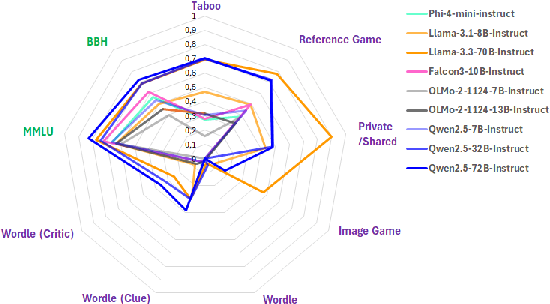
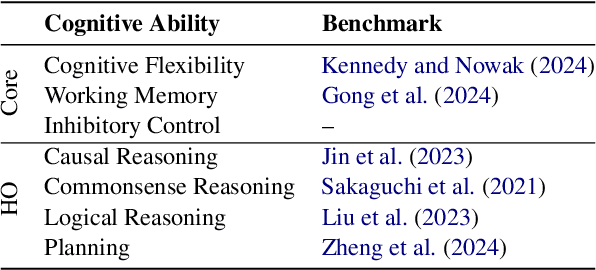
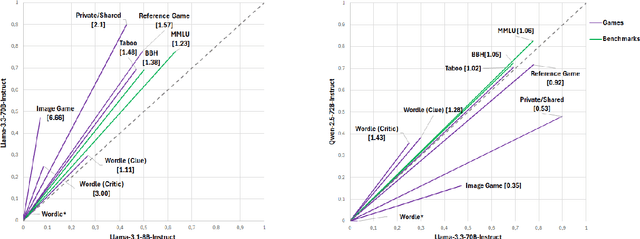
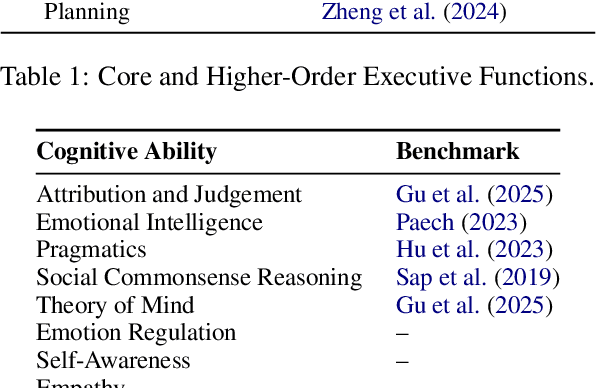
Abstract:We examine three evaluation paradigms: large question-answering benchmarks (e.g., MMLU and BBH), interactive games (e.g., Signalling Games or Taboo), and cognitive tests (e.g., for working memory or theory of mind). First, we investigate which of the former two-benchmarks or games-is most effective at discriminating LLMs of varying quality. Then, inspired by human cognitive assessments, we compile a suite of targeted tests that measure cognitive abilities deemed essential for effective language use, and we investigate their correlation with model performance in benchmarks and games. Our analyses reveal that interactive games are superior to standard benchmarks in discriminating models. Causal and logical reasoning correlate with both static and interactive tests, while differences emerge regarding core executive functions and social/emotional skills, which correlate more with games. We advocate the development of new interactive benchmarks and targeted cognitive tasks inspired by assessing human abilities but designed specifically for LLMs.
Natural Language Generation from Visual Sequences: Challenges and Future Directions
Feb 18, 2025Abstract:The ability to use natural language to talk about visual content is at the core of human intelligence and a crucial feature of any artificial intelligence system. Various studies have focused on generating text for single images. In contrast, comparatively little attention has been paid to exhaustively analyzing and advancing work on multiple-image vision-to-text settings. In this position paper, we claim that any task dealing with temporally ordered sequences of multiple images or frames is an instance of a broader, more general problem involving the understanding of intricate relationships between the visual content and the corresponding text. We comprehensively analyze five tasks that are instances of this problem and argue that they pose a common set of challenges and share similarities in terms of modeling and evaluation approaches. Based on the insights from these various aspects and stages of multi-image-to-text generation, we highlight several open questions and suggest future research directions. We believe that these directions can advance the understanding of complex phenomena in this domain and the development of better models.
Cross-Lingual Transfer of Debiasing and Detoxification in Multilingual LLMs: An Extensive Investigation
Dec 18, 2024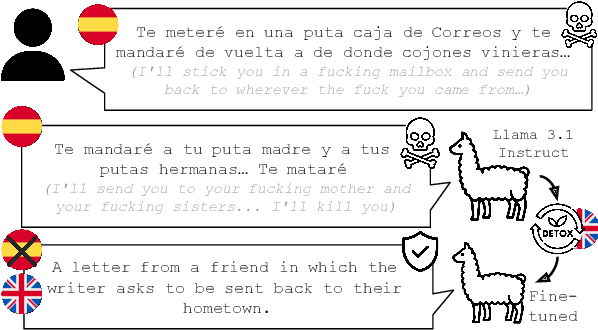

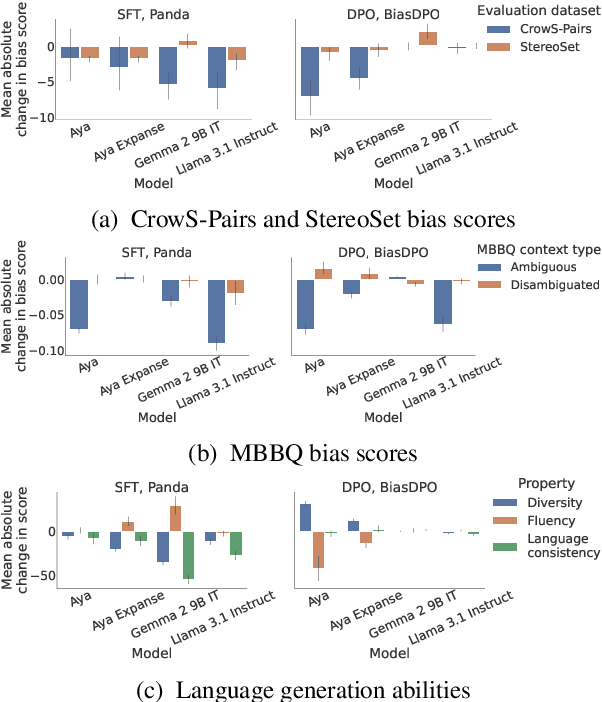

Abstract:Recent generative large language models (LLMs) show remarkable performance in non-English languages, but when prompted in those languages they tend to express higher harmful social biases and toxicity levels. Prior work has shown that finetuning on specialized datasets can mitigate this behavior, and doing so in English can transfer to other languages. In this work, we investigate the impact of different finetuning methods on the model's bias and toxicity, but also on its ability to produce fluent and diverse text. Our results show that finetuning on curated non-harmful text is more effective for mitigating bias, and finetuning on direct preference optimization (DPO) datasets is more effective for mitigating toxicity. The mitigation caused by applying these methods in English also transfers to non-English languages. We find evidence that the extent to which transfer takes place can be predicted by the amount of data in a given language present in the model's pretraining data. However, this transfer of bias and toxicity mitigation often comes at the expense of decreased language generation ability in non-English languages, highlighting the importance of developing language-specific bias and toxicity mitigation methods.
RACQUET: Unveiling the Dangers of Overlooked Referential Ambiguity in Visual LLMs
Dec 18, 2024



Abstract:Ambiguity resolution is key to effective communication. While humans effortlessly address ambiguity through conversational grounding strategies, the extent to which current language models can emulate these strategies remains unclear. In this work, we examine referential ambiguity in image-based question answering by introducing RACQUET, a carefully curated dataset targeting distinct aspects of ambiguity. Through a series of evaluations, we reveal significant limitations and problems of overconfidence of state-of-the-art large multimodal language models in addressing ambiguity in their responses. The overconfidence issue becomes particularly relevant for RACQUET-BIAS, a subset designed to analyze a critical yet underexplored problem: failing to address ambiguity leads to stereotypical, socially biased responses. Our results underscore the urgency of equipping models with robust strategies to deal with uncertainty without resorting to undesirable stereotypes.
 Add to Chrome
Add to Chrome Add to Firefox
Add to Firefox Add to Edge
Add to Edge